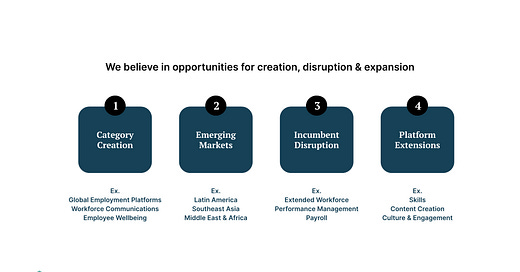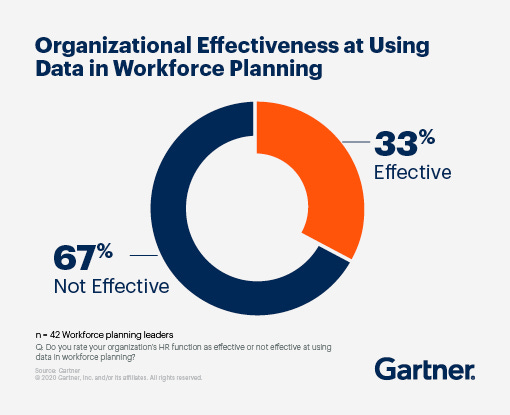Help me figure out strategic workforce planning, please.
Is it a myth, an excel, a feature, a product, a company or a market?
We spend a lot of time pondering the potential categories in Future of Work. Will new ones emerge, how will existing categories develop and morph? Some niches end up beginning massive categories, others that you expect will be big, disappoint. For instance, employee communications emerged pretty quickly as a significant new category, see examples such as Staffbase.
This is how we explain our thesis to our investors. Over the course of the fund we expect to make various investments across these buckets.
SWP
I have been waiting and hoping companies would do strategic workforce planning (SWP) since I was a boy. I wrote about it at Gartner, and I have been involved in various efforts to build SWP product capabilities over the years. Now as a VC, I’ve seen a couple of interesting solutions, but nothing that I felt was going to be a really big business.
By SWP I mean longer term workforce planning, not the short term operational stuff (where there are some very impressive capabilities, both from start ups and incumbents).
Sure, there are some products that help a bit, but SWP hasn’t really become a thriving category. I’m trying to figure out why, and what would need to change to make it one.
I’m not the only one saying this
John Sullivan notes: “HR’s almost nonexistent workforce planning has created our most costly business impact this century. And those billions in business damages have been created primarily over the last decade. We have had a constant mismatch between a company’s talent needs and its workforce capabilities.” Do read the whole article.
My former employer Gartner, has this nice graph.
“Just 46% of organizations feel their HR technology is being used to inform their business or enterprise strategy”, notes Stacey Harris.
I’ve a bunch of suppositions and assertions. Please challenge these.
Given all the long term demographic challenges facing organizations, the shifts to remote and global work, new automation technologies in manufacturing and many more extrinsic pressures, you would think that HR leaders would be jumping up and down waving their wallets, demanding better strategic workforce planning solutions, but I’m not sure that they are.
Often, software develops to automate or enhance an existing manual business process. As most organizations don’t have even a have manual SWP processes, there isn’t an obvious replacement play.
There aren’t standards for SWP, unlike in financial planning.
When companies do SWP, it is typically bespoke and external consulting led, and done by a relatively small team. There isn’t a large volume of users that would buy it. Tools that support consultant led engagements don’t typically scale as products.
A lot of the data that you need for SWP isn’t HR data. It’s from elsewhere in the business, or outside the business altogether. The APIS haven’t been there to get the data, and the data quality (even inside HR) isn’t great.
Skills and jobs frameworks have traditionally been really expensive and complex to maintain.
Most products to date have rudimentary, linear models for workforce growth simulation, and while the visualization layer has improved, the existing products aren’t compelling. Excel wins so far.
Some organizations will just use the financial planning tools to do a bit of SWP, but it hasn’t really been a deep R&D focus from the FP&A vendors.
Most HR departments are still getting basic descriptive reporting and analytics working. SWP lurks on the longer term wish list.
There is a shortage of people with the skills to actually deploy and run SWP in organizations today.
So what might change this?
You would think that the recent shocks to the global economy and demographic trends would encourage organizations to take SWP more seriously. For many organizations, labour cost is the biggest operational expense. Leading HR organizations now have sophisticated workforce analytics capabilities, so you might expect that SWP is the next frontier. We might actually have some CEOs and CFOs wanting it too. Let’s see.
Integration is getting easier. APIs are improving all the time, as the tooling to manage integrations. See tools like Merge and Finch, and for more complex integrations, Snaplogic and Workato.
Benchmark data is becoming far more available (see our investments in Figures and Compa for compensation data).
Skills data is finally getting organized (see our investment in Techwolf for instance. We think fixing skills data is going to be a very big business). If we can actually define, understand and model skills, then maybe we have the “currency” for SWP?
Data visualization, data wrangling, model building and integration techniques are moving forward rapidly.
Applying scenario planning to workforce related scenarios.
There is probably an AI angle to this, or at least some nifty statistics models.
If a more robust demand for SWP emerges, then who is more likely build something awesome and win?
Or will there be a product so awesome that it will create demand itself?
New specialist players?
Existing HR analytics vendors?
Existing application vendors (core HR, learning, Recruiting etc)
Broad ERP vendors with HR, Finance and Analytics capabilities.
Financial planning vendors?
If, as an organization, you are doing SWP well, I would love to know about it, what tooling are you using? What are you missing? Have you rolled your own, or is there some awesome start up I don’t know about?





I have been working on SWP as a "talent supply chain" for some time, because my colleagues and I have a pretty good skill data set. I am a believer - I think the way we do planning should resemble more a supply chain, with scenarios, than today's cottage industry. I am not saying that people are "boxes" that move around, I am just saying that the unit of measure should be skills and/or capabilities, and that should drive planning.
My impression is that your hypotheses are right on the money, and I would add a double click on
(a) data granularity sometime mismatched
(b) need to maintain this as master data in a decentralized way (master data management is a thorny problem in many companies, above and beyond HR data)
(c) HR culturally doesn't do data very well (sorry) compared to other functions, apart from administrative records maintenance
(d) this thing should be incredibly useful to the lines of business, and HR should be a COE the same way the CIO does some data centralization - but I think there's both HR not selling/explaining this well to LoBs and LoBs not being strategic enough for this part of their work (you would hope that after a decade of "war for talent" things would be different, but hey...)
Professional services firms are typically better at it because de facto their product is their people. But not always.
Interesting topic. I've never thought of it as a "SWP" but it's definitely something I come across a lot and we try to solve it as well. According to my observations from companies of various sizes I've seen from inside (250+) it seems to me that my experience overlaps with what Gianni writes. It naturally varies according the type of employees and the size of a company.
1. SWP should start from good job description - skills, qualification, ...
2. the demand for future job needs (who we exactly need) is formulated outside HR, by business owners, often by first line managers
3. The quality of the formulation vary, HR is if often just collecting these needs, a lot of important details is "lost in translation" during internal communication
4. There is often a problem even to formulate and structure the job positions itself, the structuring of job descriptions is the next level
5. the less structured JDs you have, the less you can anticipate and plan future job needs. In general it works better in more structured companies with blue-collar workers (e.g.manufacturing), where JDs are more standardized. In less structured and standardized companies with office workers, there is a much harder exercise
6. JDs are usually written as plain text, not structured = thus a much worse input for any strategic planning
7. People and JD are not just numbers = that's why it works in financial planning not in HR
8. SWP we should start from job NEEDS (outcomes > outputs > proceses, activities > skills, qualification, etc), then to match them to to people, job positions.
9. Despite above it can work, but we need three components: App + centralised HR master data (including a inputs for JDs, skills etc.) as a key enablers + company culture that includes a strategic planning with "PDCA" mindset (btw one of the best management principles ever :)